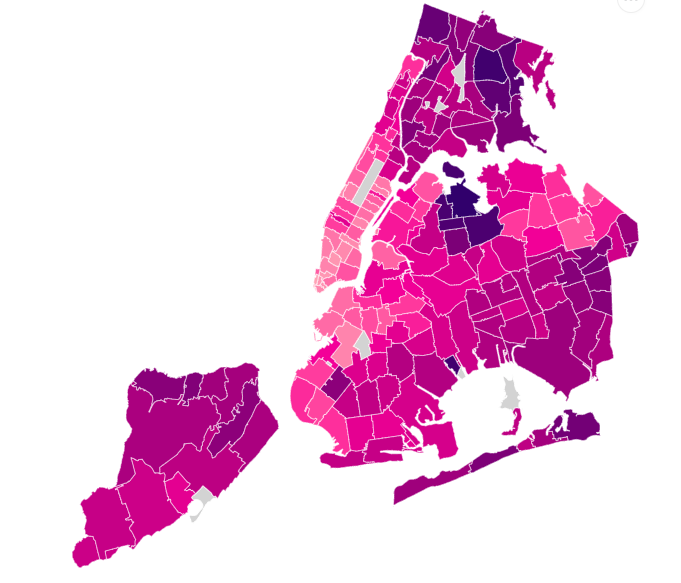
On May 15, the New York City Council held an important hearing on the overall plans for the test-and trace program to get the city safe for a phased re-opening.
The inquisitive and detailed nature of the Council members’ questions proved the Council is well equipped to oversee our city’s journey through the epidemic. The City Council needs a follow up hearing by July 1 to concentrate on the plan for the “hot zones”, which can be defined as zip codes with death rates of 500 or higher per 100,000 population or zip codes with case rates about 3,500 or higher per 100,000 population. These estimates are based on the New York City Department of Health’s COVID-19 epidemiological data posted on the Department’s website on May 31, 2020.
As of May 31, hot zones include: East New York, Canarsie-Flatlands, Rockaway, and Coney Island in Brooklyn; Northeast Bronx, Pelham, Morrisania, Kingsbridge, and Fordham in the Bronx; and West Queens, Elmhurst, Flushing, and Jackson Heights in Queens. The case rates and death rates in the hot
zones areas are currently two to four times greater than their neighboring zip codes or districts. Even more glaring is that the high-risk areas are experiencing death rates eight to 10 greater than zip codes with the least burden.
The practical reasons for this disparity include more crowded, intergenerational apartments and constrained employment opportunities that skew toward the service sector. These factors can all be traced back to the relative poverty experienced by people of color in New York City and decades of disinvestment in segregated neighborhoods.
These hot zones are important to all of New York City and the region because we will be dealing with this epidemic until, at least, early 2021 (with the hopes for a vaccine to eradicate the disease). Many parts of the city have been able to adapt to the mitigation measures for social distancing; however, we also have many areas where social distancing is almost impossible. The virus has already moved from high transmission throughout the city to these most vulnerable pockets, the hot zones, the same way a
stream of rainwater will search out the lowest crevasses in the woods. What is clear is that the virus will continue to fester in the Hot Zones and feed into occasional city-wide surges, based on our challenges in social distancing. The protests and demonstrations crowds from May 29-31 are outliers in creating conditions for a case surge that will likely become evident in the next 1-3 weeks. Beyond last weekend’s protests, we will continue to have surges for many months. The hot zones are effectively reservoirs for the virus to have high community transmission, multiply, and survive.
If you live or work in the hot zones, the pain and suffering in the community is palpable. My psychiatric patients live in many of the hot zones. We spend months and years supporting our psychiatric patients on their pathway to recovery. They have returned to schools and jobs and marriages and mortgages.
Today, I am at a loss for how to advise them. For some of these neighborhoods, I fear my patients should not leave their building for the chance they contract COVID-19 and transmit it to their elderly family members. I have multiple psychiatric patients who have delayed necessary procedures for fear of COVID-19 transmission. I also have patients living in senior residences in hot zones, from which emergency medical service personnel will actively resist taking a delirious patient to the emergency room, for fear of COVID-19 transmission .
 CityViews are readers’ opinions, not those of City Limits. Add your voice today!
CityViews are readers’ opinions, not those of City Limits. Add your voice today!
The city’s resources must be deployed to control and eventually eradicate the virus in the hot zones. If the baseline requirements for contact tracing is 30 tracers per 100,000 during an epidemic, then the hot zones will likely require much more. Testing may eventually need to reach 30 to 50 percent of the population in these districts.
Finally, there will be a much greater need for isolation spaces than the 1,200 hotel rooms quoted during the May 15 hearing. Aside from the homeless, there is a significant percentage of New Yorkers living in “crowded apartments” (more than 1.5 to a room). When they test positive, we need a coherent plan for them to reduce transmission.
Given the complexity of the tasks at hand and the potential for bureaucratic barriers to action, the New York City Council Health Committee should hold a follow up hearing to confirm the strategy for COVID-19 control in the hot zones. This hearing should happen within the next 30 days as we are at risk for surges right now, especially following this weekend’s demonstrations, and given the city’s looming, phased re-opening. There should be special attention given to how the test-and-trace program is adapting, given that the Department of Health is not in their usual role of overseeing the contact tracing operations. The Council should also scrutinize how the test-and-trace corps will gain and retain the trust of residents in these COVID-19 hot zones, given they have been historically disenfranchised.
The resolve of all city government officials should reflect the central understanding that New York City will continue to be at risk of COVID-19 case surges until our most vulnerable neighborhoods have the tools needed to reduce transmission. The entire city needs to heal together or not at all.
Arkaprava Deb is a psychiatrist working with severe mental illness and emergency psychiatry.








